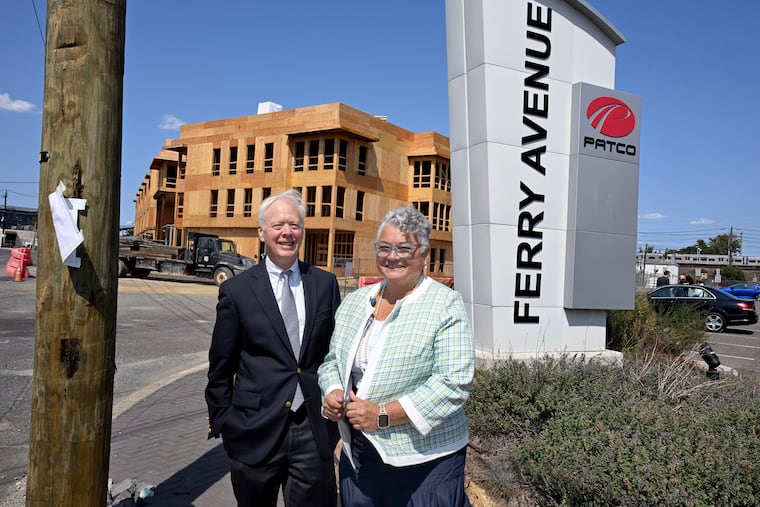A pioneering Camden development next to a PATCO station is getting a reboot
Camden built a transit-oriented development in the early 1970s, before TOD was a thing. But after floundering in the 1990s, the area around the Ferry Avenue Station will get a refresh.

In the early 1970s, the mix of residential, office, and retail development on the periphery of PATCO’s Ferry Avenue Station was ahead of its time.
And despite floundering in the 1990s as the office buildings and some of the apartments went vacant, Camden’s pioneering attempt at transit-oriented development has been getting an incremental refresh.
The latest redevelopment project under construction on a portion of the 18-acre site — much of which is still devoted to parking ― is a mixed-use building of 47 affordable senior rental apartments above a Virtua Our Lady of Lourdes Hospital primary-care facility.
“In terms of smart growth, public transportation, housing, economic growth, and quality, accessible health care, it’s a beautiful model,” said Nick Cangelosi, senior vice president of the Michaels Organization.
The Camden-based company is Virtua’s partner in the $24 million project, the cost of which was underwritten by federal, state, and private funding. “This project is something really special,” Cangelosi said. Construction is expected to be completed in the spring.
The three-story building will be named Oliver Station in honor of the Rev. Thomas Clement Oliver (1818 -1900), an Underground Railroad conductor associated with Camden’s historic Macedonia African Methodist Episcopal Church.
“This opportunity to provide the community with primary care is very important to our mission,” said Alan Pope, chief medical officer of Virtua Our Lady of Lourdes Hospital.
The new facility will not provide emergency or urgent-care services but will serve the primary-care needs of people in the building and nearby neighborhoods, as well as among the 1,200 PATCO riders who use the station on a typical weekday.
“People living near PATCO stations could use [the train] and come here for their primary care,” Pope said.
Details about the hours of service at the facility are being worked out, Virtua officials said.
Development around PATCO station didn’t age well
The 1969 opening of the PATCO line between Center City Philadelphia and Camden County was seen as a boost for Camden and included two stops downtown as well as the Ferry Avenue station.
There, at the city’s border with Collingswood and Woodlynne, the availability of 24-hour train service sparked construction of 500 apartments as well as two office buildings.
The larger of the two office buildings, in the ’70s, was home to a ground-floor restaurant and bar called King Zog’s Taverne, in honor of a long-deceased Albanian royal.
But the overall development’s utilitarian design and location along the fringe of the 1,900-space parking lot didn’t age well.
And for years before it was finally demolished to make way for Oliver Station, the long-defunct Plaza office building had trees growing on its roof and vegetation sprouting from its windows.
“I could see that building from my front door, and to watch it become dilapidated and an eyesore was so disheartening,” said retired city police officer Tracey Hall, who bought her Whitman Park home 30 years ago.
“I used to go to the dentist in that building. The big office building was like a hub where you could go to the bank and to PSE&G to pay your bill,” Hall said.
“When all that fell apart you had the broken-window syndrome. There were [more and more] vacancies.”
A Camden redevelopment plan, followed by a rebirth
The Whitman Park Redevelopment Plan the city adopted in 2005 called for capitalizing on the presence of the PATCO station and encouraging transit-oriented development nearby.
The Rochester, N.Y.-based Conifer real estate and development firm rehabilitated the larger of the two vacant office buildings into an 86-unit senior building called Ferry Manor that same year.
Collaborating with the Camden nonprofit Parkside Business and Community in Partnership (PBCIP), the firm went on to build Conifer Village at Ferry Station, a 50-unit rental development for senior citizens. The 48-unit Ferry Landing rental complex for families followed.
“We’ve been proud to be part of the Camden community for over 20 years,” said Rogelio Pine, Conifer vice president for development.
Pine said his company engages with “residents, stakeholders, and partners like Parkside to create developments that meet each community’s unique needs. We’re committed to building not just homes, but vibrant places where people can truly thrive.”
A brighter future?
“There is potential for even more development around Ferry Station, and our stations in Collingswood and Westmont are a fantastic example of this,” said John T. Hanson, chief executive officer of the Delaware River Port Authority, which oversees PATCO.
“Places in close proximity to transit will likely experience more development and increasing property values,” he said, citing what he described as the approaching “inflection point in the shift from a car culture to a transit culture.”
Said Camden Mayor Victor Carstarphen: ”This facility will be a quality place and will be a catalyst for more development.”
Virtua officials said they look forward to Oliver Station being a “front door” members of often-underserved communities can easily access.
“We could definitely use it,” said Whitman Park resident Juan Mendez, 71.
Hall said she hopes her nonprofit Daelight Foundation, which aims to prevent suicide, will be able to collaborate with Virtua in the new space.
“I watched my neighborhood get bad and now it’s coming back,” she said.
“But all that good stuff coming back has been a long time coming.”